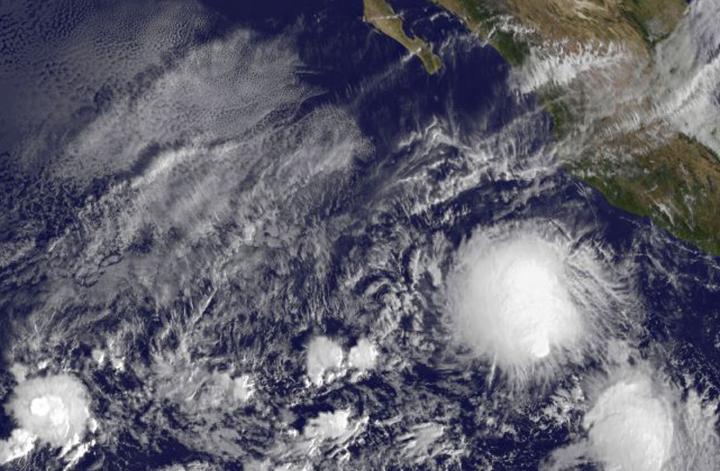Twenty-first depression forms in eastern Pacific Ocean

On Nov. 18 at 1500 UTC (10:00 a.m. EST), the NOAA's GOES-West satellite saw the Tropical Depression 21E form well southwest of the western Mexican coast. Credits: NASA/NOAA GOES Project
On Nov. 18 at 1500 UTC (10:00 a.m. EST), the NOAA's GOES-West satellite saw the Tropical Depression 21E form well southwest of the western Mexican coast. The storm appeared rounded in GOES imagery, but the storm was being affected by wind shear.
Forecaster Kimberlain at the National Hurricane Center said “These data and first-light visible satellite imagery also indicate that the center of the cyclone is near the southeastern edge of large mass of cold-topped convection, suggesting the presence of some southeasterly [vertical wind] shear.”
At 11 a.m. EST (1600 UTC), the center of Tropical Depression Twenty-One-E was located near latitude 13.0 north, longitude 107.2 west.
That puts the center about 455 miles (735 km) south-southwest of Manzanillo, Mexico. The estimated minimum central pressure is 1005 millibars.
The depression was moving toward the north near 2 mph (4 kph), and this general motion is expected to continue today.
A turn toward the north-northwest and then northwest is expected Thursday and Friday with an increase in forward speed. Maximum sustained winds are near 35 mph (55 km/h) with higher gusts.
Some strengthening is forecast during the next 48 hours, and the depression is expected to become a tropical storm tonight or Thursday, Nov. 19.
The National Hurricane Center forecast track turns the storm away from the coast, toward the west-northwest. For updated forecasts, visit: http://www.
Media Contact
All latest news from the category: Earth Sciences
Earth Sciences (also referred to as Geosciences), which deals with basic issues surrounding our planet, plays a vital role in the area of energy and raw materials supply.
Earth Sciences comprises subjects such as geology, geography, geological informatics, paleontology, mineralogy, petrography, crystallography, geophysics, geodesy, glaciology, cartography, photogrammetry, meteorology and seismology, early-warning systems, earthquake research and polar research.
Newest articles

Webb captures top of iconic horsehead nebula in unprecedented detail
NASA’s James Webb Space Telescope has captured the sharpest infrared images to date of a zoomed-in portion of one of the most distinctive objects in our skies, the Horsehead Nebula….

Cost-effective, high-capacity, and cyclable lithium-ion battery cathodes
Charge-recharge cycling of lithium-superrich iron oxide, a cost-effective and high-capacity cathode for new-generation lithium-ion batteries, can be greatly improved by doping with readily available mineral elements. The energy capacity and…

Novel genetic plant regeneration approach
…without the application of phytohormones. Researchers develop a novel plant regeneration approach by modulating the expression of genes that control plant cell differentiation. For ages now, plants have been the…





















